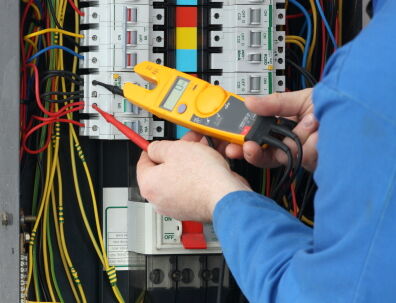
Electrical abbreviations save time and preserve safety. They are used in industries such as automotive and construction, plus in anything to do with electrical wiring, electronic device repair, electronic device manufacturing, and telephony. Because electrical work involves significant cost and potential safety risks, understanding these abbreviations and acronyms is important for everyone involved.
Common Electrical Abbreviations and Acronyms
Electrical work involves space constraints of many devices and panels. Since it doesn't make sense to write out the full terms every time, shorter abbreviations are used for various circuits, conduits, sizes, standardized tools, and more. Here are several examples of common electrical wiring abbreviations:
- A – Ampere, sometimes shortened to "amp," the basic unit of electric current
- AC – Alternating Current (as opposed to direct current) or Air Conditioning (depends upon context)
- AF – Audio Frequency or Audible Frequency, typically measured using the SI unit of hertz (Hz)
- ANSI – American National Standards Institute
- BEV – Billion Electron Volts
- BW – Bandwidth, a concept in signal processing that refers to the difference between the upper and lower limits of a band of frequencies
- CBI – Complementary Binary, referring to a system of codes
- CFL – Compact Fluorescent Light or Compact Fluorescent Lamp
- dB – Decibels, a unit and scale for measuring sound or signal level
- DC – Direct Current, a unidirectional flow of electric charge as in a battery
- e – Efficiency, referencing the useful power output given the total power consumed, expressed as a fraction
- EMF – Electromagnetic Field or Electromotive Force
- EV – Electronvolt, a unit of energy similar to joules
- FDC – Flow Duration Curve, describing the relationship between magnitude and duration of stream flows
- FCEV – Fuel Cell Electric Vehicle
- G – Conductance, the inverse of electrical resistance (R)
- GFCI – Ground Fault Circuit Interrupter, a type of circuit breaker
- H – Gross Head, determining the maximum power that can be produced
- h – Net Head, also known as effective head
- Hz – Hertz, the SI unit of frequency, defined as one cycle per second
- I – Current, a flow of electric charge
- J – Joule, the SI unit of energy equal to one watt for one second
- kW – Kilowatt, equal to 1,000 watts of electrical power
- LF – Low Frequency, referencing the radio frequency range of 30 to 300 kHz
- Li–ion – Lithium Ion, a type of rechargeable battery
- MAD – Mean Annual Discharge
- MW – Megawatt, equal to one million watts, usually referenced in relation to output of a power station
- OCV – Open Circuit Voltage, the difference in electrical potential when disconnected from a circuit
- POV – Peak Operating Voltage
- Q – Charge, denoting a quantity of electricity expressed in coulombs (C)
- R – Resistance, measured and expressed in ohms (Ω)
- RF – Radio Frequency, describing the rate of oscillation
- SW – Short Wave or Shortwave, as in the case with shortwave bands and shortwave radio
- V – Voltage/Volt, a unit of electromotive force
- VA – Volt-Ampere, a unit of electrical power
- VOM – Volt Ohm Meter, a device also known as a multimeter or multitester
Wire Color Abbreviations
Different electrical wires perform different tasks. Colored wires are found in branch circuits, which are the wiring between a circuit breaker or other protective device and an electrical load. If you’re unsure about the color wire you’re working with, take a look at these abbreviations and definitions.
Lower Voltage Colors
Most homes and offices use 120, 208, and 240 volt AC wiring systems. These systems are found in outlets or other electrical circuits throughout the home. The colors of these lower voltage wires include:
- Black (BK) – Live wire, includes two hot wires (120 volts each) and one neutral wire
- Red (RD) – Secondary live wire in a 240 volt system or a switched power in a 120 volt system
- Blue (BU) – Live wire pulled through conduit, often used as a traveler for multiple-way switches
- Green (GN), Green with a Yellow Stripe, and Bare Wires – Grounding wires only
- White (WH) – Neutral conductor
Higher Voltage Colors
Heavy-duty industrial equipment operates at a higher voltage (277/480 volts). For that reason, you’ll find different colors marking these wires than you’ll find in the walls of your house or office. These wire colors are:
- Brown (BN) – Live wire. Like the black wire above, it has two hot wires and one neutral wire, but at a higher voltage.
- Orange (OG) – Secondary live wire or switched power (like red), Phase 2 - Orange
- Yellow (YE) – Live wire pulled through conduit, often used as switch legs that connect switches to their electrical source
- Green (GN), Green with a Yellow Stripe, and Bare Wires – Grounding wires only
- Gray (GY) – Neutral conductor
Even if you’re dealing with a wire that you don’t think is live, it’s best to leave it alone. Consult an electrician or other professional if you’re not sure about the wiring system you have.
More Electricity Resources
If you’d like to learn more about electricity and electrical energy, there are many helpful articles to steer you in the right direction. You can find everyday examples of electrical energy with a list of household items. Or, if you’re interested in other types of kinetic energy, check out a resource that explains more about mechanical, radiant, thermal, and sound energy.